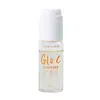What's inside
What's inside
 Key Ingredients
Key Ingredients

 Benefits
Benefits

 Concerns
Concerns

 Ingredients Side-by-side
Ingredients Side-by-side

Water
Skin Conditioning3-O-Ethyl Ascorbic Acid
Skin ConditioningPropylene Glycol
HumectantAlpha-Arbutin
AntioxidantPropanediol
SolventAloe Barbadensis Leaf Extract
EmollientGlycerin
HumectantBellis Perennis Flower Extract
Skin ConditioningPhenoxyethanol
PreservativeSodium Hyaluronate
HumectantButylene Glycol
HumectantSodium Bisulfite
AntioxidantXanthan Gum
EmulsifyingCalendula Officinalis Flower Extract
MaskingPotassium Sorbate
PreservativeSodium Phosphate
BufferingWater, 3-O-Ethyl Ascorbic Acid, Propylene Glycol, Alpha-Arbutin, Propanediol, Aloe Barbadensis Leaf Extract, Glycerin, Bellis Perennis Flower Extract, Phenoxyethanol, Sodium Hyaluronate, Butylene Glycol, Sodium Bisulfite, Xanthan Gum, Calendula Officinalis Flower Extract, Potassium Sorbate, Sodium Phosphate
Water
Skin Conditioning3-O-Ethyl Ascorbic Acid
Skin ConditioningAlpha-Arbutin
AntioxidantHoney
HumectantAloe Barbadensis Leaf Juice
Skin ConditioningPropanediol
SolventPolyacrylate Crosspolymer-11
Emulsion StabilisingPropylene Glycol
HumectantSodium Benzoate
MaskingChlorphenesin
AntimicrobialAllantoin
Skin ConditioningTetrasodium EDTA
Hydrolyzed Hyaluronic Acid
HumectantDipotassium Glycyrrhizate
HumectantTephrosia Purpurea Seed Extract
Skin ConditioningCucumis Sativus Fruit Extract
EmollientSodium Metabisulfite
AntioxidantPotassium Sorbate
PreservativeWater, 3-O-Ethyl Ascorbic Acid, Alpha-Arbutin, Honey, Aloe Barbadensis Leaf Juice, Propanediol, Polyacrylate Crosspolymer-11, Propylene Glycol, Sodium Benzoate, Chlorphenesin, Allantoin, Tetrasodium EDTA, Hydrolyzed Hyaluronic Acid, Dipotassium Glycyrrhizate, Tephrosia Purpurea Seed Extract, Cucumis Sativus Fruit Extract, Sodium Metabisulfite, Potassium Sorbate
Ingredients Explained
These ingredients are found in both products.
Ingredients higher up in an ingredient list are typically present in a larger amount.
You might know this ingredient as Ethyl Ascorbic Acid, a more stable version of ascorbic acid.
Like other types of vitamin C, this ingredient has many benefits including reducing wrinkles, skin soothing, dark spot fading, and fighting against free radicals.
3-O-Ethyl Ascorbic Acid interferes with the process of skin darkening, helping to reduce hyperpigmentation. It also encourages the skin to produce more collagen.
Once applied, 3-O-Ethyl Ascorbic Acid is converted to Vitamin C deeper in the skin's layers. This process is slow but makes this ingredient more tolerable for skin.
The optimum pH range for this ingredient is 4 - 5.5
Learn more about 3-O-Ethyl Ascorbic AcidAlpha-Arbutin is made from hydroquinone and glucose. It may also be derived from the fermentation of soybeans.
This ingredient an antioxidant, meaning it helps protect your skin cells against damage.
Studies show this ingredient helps improve hyperpigmentation and fade discoloration.
Alpha-Arbutin may be used with other ingredients that help with hyperpigmentation. These ingredients include retinol, Vitamin C, niacinamide, and tranexamic acid.
Learn more about Alpha-ArbutinPotassium Sorbate is a preservative used to prevent yeast and mold in products. It is commonly found in both cosmetic and food products.
This ingredient comes from potassium salt derived from sorbic acid. Sorbic acid is a natural antibiotic and effective against fungus.
Both potassium sorbate and sorbic acid can be found in baked goods, cheeses, dried meats, dried fruit, ice cream, pickles, wine, yogurt, and more.
You'll often find this ingredient used with other preservatives.
Learn more about Potassium SorbatePropanediol is an all-star ingredient. It softens, hydrates, and smooths the skin.
It’s often used to:
Propanediol is not likely to cause sensitivity and considered safe to use. It is derived from corn or petroleum with a clear color and no scent.
Learn more about PropanediolPropylene Glycol is an odorless, colorless liquid. As a humectant, it helps skin retain moisture. It also aids in delivering active ingredients.
Another role of this ingredient is preventing a product from melting or freezing. Propylene glycol also adds antimicrobrial properties to a product, elongating product lifespan.
This ingredient is considered an organic alcohol and commonly added into both cosmetics and foods.
Those with sensitive skin or conditions may develop a rash when using this ingredient.
Learn more about Propylene GlycolWater. It's the most common cosmetic ingredient of all. You'll usually see it at the top of ingredient lists, meaning that it makes up the largest part of the product.
So why is it so popular? Water most often acts as a solvent - this means that it helps dissolve other ingredients into the formulation.
You'll also recognize water as that liquid we all need to stay alive. If you see this, drink a glass of water. Stay hydrated!
Learn more about Water